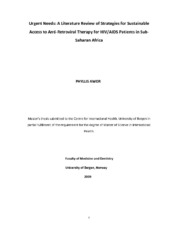| dc.description.abstract | Two thirds of all people living with HIV and 70% of all who require anti-retroviral therapy (ART) live in sub-Saharan Africa (SSA). Despite unprecedented international commitment to the HIV/AIDS epidemic, only 30% of all who need ART in SSA are currently receiving it. The funding gap for HIV/AIDS in this region remains daunting despite huge donor contributions. The current global economic crisis could greatly affect the accelerated efforts to halt spread of HIV and to achieve universal access to HIV/AIDS treatment for all who require it, and the other millennium development goals (MDGs). There is urgent need for evidence-based and sustainable solutions for access to ART for patients in SSA, which has the highest HIV/AIDS burden. This study set out to assess the current situation and identify pragmatic and sustainable strategies for access to ART for HIV/AIDS patients in SSA. A comprehensive literature review of available print and electronic resources was undertaken including journal articles, reports, policy documents and books. SSA faces numerous challenges in access to ART: there is poor infrastructure for health; a critical shortage of health workers; overcrowded health units and inexistent chronic care management. The western model of individualized HIV/AIDS treatment cannot be adopted here. Bigger challenges are being faced with scaling up prevention of HIV; adherence to ART and management of second line ART. Crippled government funding for health and unstable donor contributions for HIV compound the health crisis even more. Primary health Care strategies which have been well known for 30 years are being adopted for the HIV/AIDS crisis in SSA. The WHO public health approach to ART in resource-limited settings emphasises equitable and comprehensive access to ART for all through simplified and standardized drug regimens, treatment protocols and patient monitoring. Task shifting and re introduction of community health workers is necessary to rapidly expand the health workforce. Also, combining comprehensive HIV prevention with treatment can effectively reduce new infections. The current available resources for HIV should be maximized for health system strengthening through improving infrastructure, expanding and training the health workforce and empowering local educational and research institutions to adequately respond to the HIV/AIDS crisis. The civil society and activists have a key role in maintaining HIV/AIDS on the political agenda thus ensuring long term local and international commitment to free and universal access to HIV treatment and care for all. | en_US |
